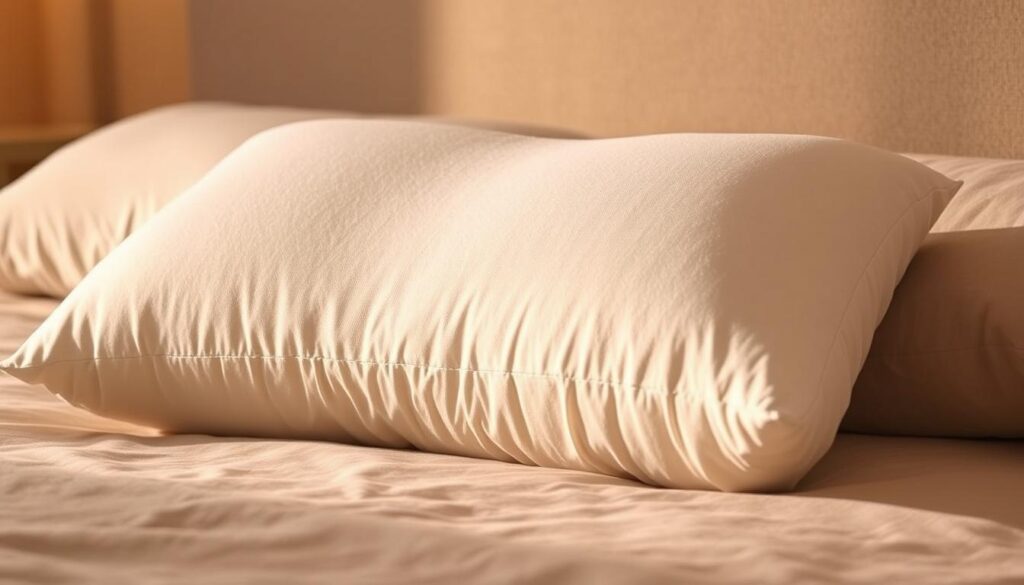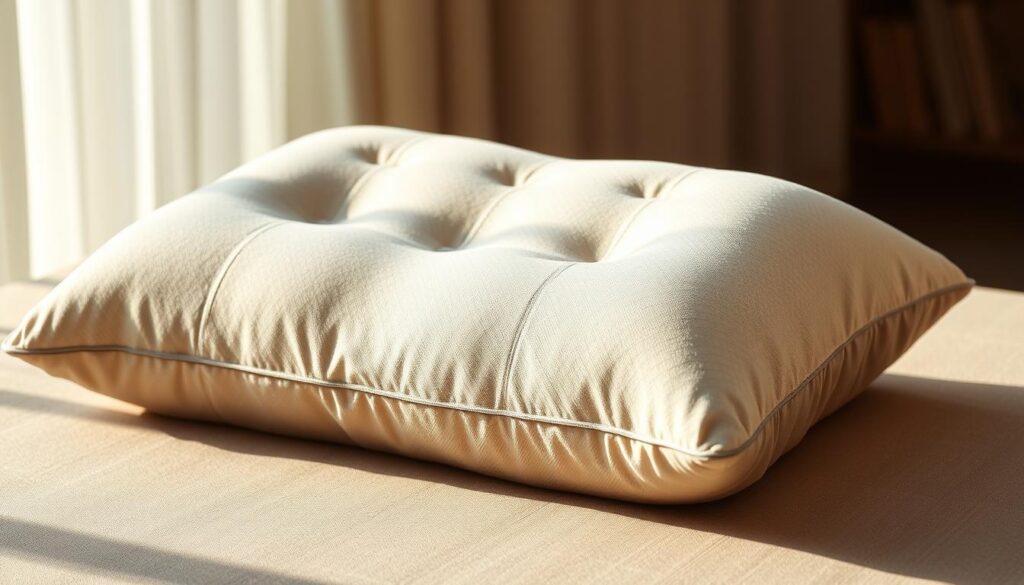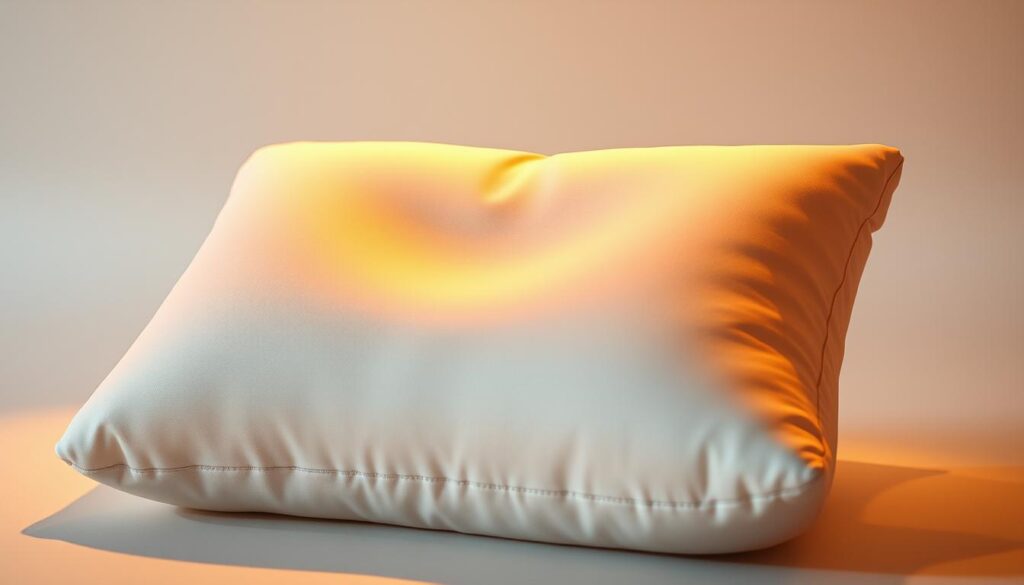Do you wake up feeling stiff or struggle to find comfort at night? Many people experience discomfort in their upper back, often due to improper support during sleep. A Pillow for Upper Back Pain can make a significant difference by aligning your spine and reducing tension, helping you rest more comfortably.
A pillow and a person showing upper back pain
Choosing the correct support for your neck and shoulders is essential for a restful night. A well-designed pillow can help maintain proper posture, preventing stiffness and soreness. This guide will walk you through the features and benefits of finding the ideal option for your needs.
Experts agree that proper alignment is key to reducing discomfort. By understanding how a pillow supports your upper back, you can improve your sleep quality and wake up feeling refreshed. Let’s explore how to make the right choice for your health and comfort.
Key Takeaways
- Proper support can reduce upper back discomfort during sleep.
- The right pillow helps maintain spinal alignment.
- Choosing the correct option improves sleep quality.
- Expert insights highlight the importance of proper posture.
- This guide will help you find the ideal solution for your needs.
Understanding Upper Back Pain and Its Impact on Sleep
Many people underestimate how their sleep habits affect their spine. The way you position yourself at night can either support or strain your upper back. Poor alignment often leads to discomfort, making it harder to rest well.
The Connection Between Sleep Position and Spine Alignment
Your sleeping position plays a key role in maintaining proper spinal alignment. Side sleepers, for example, need a pillow that keeps their neck level with their spine. Back sleepers, on the other hand, require support to prevent their head from tilting too far forward or backward.
Misalignment can lead to muscle strain and tension. Over time, this can worsen existing issues or create new ones. Choosing the right position and support can make a big difference in how you feel.
Acute, Chronic, and Neuropathic Back Pain Explained
Not all discomfort is the same. Acute pain is short-term and often caused by injury or strain. It usually resolves with rest and proper care. Chronic pain, however, lasts for months or even years and can disrupt sleep patterns.
Neuropathic pain stems from nerve damage and can feel like burning or tingling. This type of discomfort often worsens at night, making it harder to relax. Understanding these differences helps in finding the right solutions.
|
Type of Pain |
Duration |
Common Causes |
|
Acute |
Short-term |
Injury, muscle strain |
|
Chronic |
Long-term |
Arthritis, ongoing stress |
|
Neuropathic |
Varies |
Nerve damage, diabetes |
Proper spinal alignment is critical in reducing discomfort during sleep. By addressing the root causes and choosing the right support, you can improve your sleep quality and overall well-being.
The Importance of Proper Spinal Alignment
Proper spinal alignment is the foundation of a healthy sleep routine. When your spine is correctly positioned, it reduces strain on your muscles and joints. This leads to better posture, improved circulation, and enhanced mobility.

A human spine in perfect alignment, with vertebrae stacked neatly and a subtle curve in the lower back. The spine is bathed in warm, natural lighting, casting soft shadows that accentuate the contours. The background is a serene, minimalist setting, allowing the spinal column to be the focal point. The image conveys the benefits of proper spinal alignment, highlighting the importance of maintaining a healthy posture for upper back pain relief.
Maintaining the right alignment during sleep is crucial. It ensures that your head neck and spine are in harmony, preventing discomfort. Over time, this can help you wake up feeling refreshed and pain-free.
How a Supportive Pillow Enhances Posture
A well-designed pillow provides the necessary support to keep your spine aligned. It helps distribute weight evenly, reducing pressure on your upper back. This is especially important for those who sleep on their side or back.
Experts agree that the right pillow can make a significant difference. “Proper alignment during sleep is essential for long-term health,” says Dr. Jane Smith, a renowned sleep specialist. By choosing a pillow that supports your body, you can improve your posture and overall well-being.
Improved posture doesn’t just benefit your sleep. It also enhances your daily activities by reducing fatigue and discomfort. Investing in the right support is a step toward a healthier, more comfortable life.
How Pillows Can Relieve Upper Back Pain
The materials used in your sleep accessories play a crucial role in comfort. Two popular options, memory foam and latex, are known for their ability to provide pressure relief and support. These materials help reduce discomfort by aligning your spine and easing tension in your upper back.
The Role of Memory Foam and Latex in Pressure Relief
Memory foam is designed to contour to your body’s shape. It molds to your neck and shoulders, offering consistent support throughout the night. This helps distribute weight evenly, reducing pressure points and promoting proper alignment.
Latex, on the other hand, provides firm yet responsive support. It’s naturally resilient, bouncing back to its original shape after use. This makes it durable and ideal for those who prefer a firmer feel. Both materials are excellent for reducing discomfort and improving sleep quality.
|
Material |
Key Features |
Benefits |
|
Memory Foam |
Contours to body, consistent support |
Reduces pressure points, promotes alignment |
|
Latex |
Firm, responsive, durable |
Provides firm support, long-lasting |
Both memory foam and latex contribute to pressure relief by minimizing stress on your body. This leads to a more comfortable and restorative sleep experience. Choosing the right material depends on your personal preferences and sleep needs.
Best Pillow for Upper Back Pain
Finding the right support for your neck and shoulders can transform your sleep experience. A well-designed sleep accessory not only enhances comfort but also addresses specific issues like tension and misalignment. Let’s explore the features that make a difference.

A plush, supportive pillow with a gentle contoured design, positioned on a neutral-toned bedding setup. The pillow features a medium-firm memory foam core and a soft, breathable outer fabric, providing optimal comfort for the upper back. The lighting is warm and diffused, creating a cozy, relaxing atmosphere. The camera angle is slightly elevated, capturing the pillow from a slightly oblique perspective to showcase its ergonomic shape and inviting appearance. The overall scene conveys a sense of comfort and pain relief, perfectly suited for the “Best Pillow for Upper Back Pain” section of the article.
Key Features and Benefits of the Ideal Pillow
An effective sleep accessory offers adjustable loft, allowing you to customize the height for optimal alignment. This feature ensures your neck and spine stay in harmony, reducing strain. Targeted neck support is another crucial element, as it helps maintain proper posture throughout the night.
Ergonomic design plays a significant role in addressing discomfort. A well-crafted sleep solution contours to your body, providing pressure relief where it’s needed most. This reduces stress on your muscles and joints, promoting a more restful sleep.
Customers often highlight the benefits of these features. One user shared, “Since switching to an ergonomic design, I’ve noticed a significant reduction in morning stiffness.” Such feedback underscores the importance of choosing the right support.
|
Feature |
Benefit |
|
Adjustable Loft |
Customizable height for proper alignment |
|
Targeted Neck Support |
Maintains posture, reduces strain |
|
Ergonomic Design |
Contours to body, relieves pressure points |
Investing in a sleep accessory with these features can make a noticeable difference. It’s not just about comfort—it’s about waking up feeling refreshed and pain-free. Choose wisely to transform your sleep and overall well-being.
Evaluating Pillow Materials for Back Pain Relief
The material of your sleep accessory can significantly impact your comfort and health. Choosing the right pillow material ensures proper support and alignment, reducing discomfort and improving sleep quality. Let’s explore the most popular options available and their benefits.
Memory Foam, Latex, and Alternative Fill Options
Memory foam is a popular choice due to its ability to contour to your body. It provides consistent support, reducing pressure points and promoting proper alignment. This material is ideal for those who need targeted relief for their neck and shoulders.
Latex offers firm yet responsive support. It’s naturally resilient and durable, making it a long-lasting option. Latex is also hypoallergenic, making it suitable for those with allergies or sensitivities.
Down alternatives provide a soft and plush feel. They are lightweight and breathable, making them a great choice for those who prefer a softer type of support. However, they may not offer the same level of firmness as other materials.
Buckwheat pillows are filled with natural hulls, offering firm and adjustable support. They are highly durable and provide excellent airflow, keeping you cool throughout the night. This material is perfect for those who prefer a firmer feel.
|
Material |
Support |
Comfort |
Durability |
|
Memory Foam |
High |
Contours to body |
Long-lasting |
|
Latex |
Firm |
Responsive |
Very durable |
|
Down Alternatives |
Soft |
Plush feel |
Moderate |
|
Buckwheat |
Adjustable |
Firm support |
Highly durable |
Customer reviews highlight the importance of choosing the right material. One user shared, “Switching to a memory foam pillow made a noticeable difference in my sleep quality.” Experts also emphasize that the right option can alleviate discomfort and improve overall well-being.
Understanding the properties of each type helps you make an informed decision. Whether you prefer the contouring of memory foam or the firmness of buckwheat, the right pillow material can transform your sleep experience.
Top Features to Look for in a Back Pain Pillow
The features of your sleep support matter more than you think. When shopping for a sleep accessory, certain elements can significantly impact your comfort and health. Let’s explore the key factors to consider for a restful night.

a high-quality pressure point relief pillow with a plush, supportive design, resting on a smooth, neutral-colored surface, with soft, natural lighting illuminating the pillow’s contours and textures, creating a soothing, therapeutic atmosphere; the pillow features strategically placed pressure-relieving zones, designed to gently cradle the head, neck, and shoulders, promoting proper spinal alignment and alleviating upper back pain; the pillow’s surface has a subtly textured, breathable fabric that invites touch and comfort, while the overall composition conveys a sense of relaxation and restorative rest
Loft, Firmness, and Pressure Point Relief
Loft refers to the height of your sleep accessory. It’s crucial for maintaining proper alignment of your head and neck. A loft that’s too high or too low can strain your muscles, leading to discomfort.
Firmness plays a vital role in providing support. A medium-firm option often works best, as it balances softness and structure. This helps reduce pressure on sensitive areas, promoting better sleep quality.
Pressure point relief is essential for minimizing discomfort. A well-designed sleep accessory distributes weight evenly, reducing stress on your shoulders and neck. This ensures you wake up feeling refreshed and pain-free.
Adjustability and Customization Options
Adjustable features allow you to tailor your sleep support to your needs. Some options come with removable inserts, letting you customize the loft and firmness. This flexibility ensures optimal comfort for different sleep positions.
Customization is another key factor. Look for options that let you adjust the fill or shape to suit your preferences. This level of personalization can make a significant difference in your sleep experience.
Experts emphasize the importance of these features. “An adjustable sleep accessory can adapt to your body’s needs, providing consistent support,” says Dr. Emily Carter, a sleep specialist. Reviews also highlight how customization enhances overall comfort.
When shopping, prioritize these features to find the right solution. A sleep accessory with proper loft, firmness, and adjustability can transform your nights, helping you wake up feeling rejuvenated.
Choosing the Right Pillow Based on Your Sleeping Position
Your sleeping position plays a crucial role in determining the type of support you need. Whether you’re a side sleeper or prefer lying on your back, the right sleep accessory can make all the difference. Proper alignment ensures your spine stays neutral, reducing discomfort and improving sleep quality.

A serene bedroom scene with a cozy, well-supported sleeping position. In the foreground, a plush, medium-firm pillow in a soft, neutral color supports the sleeper’s head and neck, maintaining proper spinal alignment. The pillow is positioned at a gentle incline, providing subtle elevation for optimal upper back and shoulder comfort. Soft, warm lighting from a bedside lamp illuminates the peaceful setting, creating a calming atmosphere. The background features a tranquil, minimalist decor, allowing the focus to remain on the thoughtfully selected pillow and its role in supporting a restful, pain-free slumber.
Recommendations for Side and Back Sleepers
Side sleepers need a thicker option to fill the gap between their head and shoulders. This helps keep the neck aligned with the spine. A medium-firm material like memory foam works well, as it contours to the body and provides consistent support.
Back sleepers, on the other hand, require a thinner option to prevent the head from tilting too far forward. A pillow with adjustable loft or a medium-firm latex option is ideal. It supports the natural curve of the neck, promoting proper alignment.
Product reviews highlight the importance of choosing the right pillow for your position. One user shared, “Switching to a thicker pillow for side sleeping eliminated my morning neck pain.” Another noted, “A thinner, firmer option transformed my back sleeping experience.”
|
Sleeping Position |
Recommended Pillow Type |
Key Benefits |
|
Side Sleeper |
Thicker, medium-firm (memory foam) |
Aligns neck and spine, reduces pressure points |
|
Back Sleeper |
Thinner, medium-firm (latex) |
Supports natural neck curve, prevents tilting |
Selecting the right pillow for your sleeping position ensures steady alignment and comfort. Whether you’re a side sleeper or back sleeper, the right choice can transform your nights and improve your overall well-being.
Innovative Pillow Technologies and Designs
Modern sleep solutions are evolving to meet the needs of every sleeper. With advancements in design, pillows now offer tailored support that adapts to individual body shapes and promotes proper alignment. These innovations ensure a more comfortable and restorative sleep experience.

A cozy, contoured pillow design with a soft, plush texture and subtle undulating curves. The pillow is illuminated by warm, directional lighting, casting gentle shadows that accentuate its sculptural form. The surface of the pillow has a satin-like sheen, reflecting the light beautifully. The pillow is positioned in a serene, minimalist setting, allowing the design to be the focal point. The overall mood is one of comfort, relaxation, and innovative approach to ergonomic support for the upper back and neck.
Contoured and Adjustable Pillow Options
Contoured pillows are engineered to follow the natural curve of the spine. This design helps maintain alignment, reducing strain on the neck and shoulders. By cradling the head and supporting the cervical spine, these pillows provide targeted relief for those with discomfort.
Adjustable options take customization to the next level. They allow users to modify the shape and loft to suit their preferences. Whether you need firmer support or a softer feel, these pillows adapt to your unique needs. This flexibility makes them ideal for a wide range of sleepers.
User testimonials highlight the benefits of these designs. One reviewer shared, “The contoured pillow eliminated my morning stiffness, and the adjustable feature lets me tweak it for perfect comfort.” Such feedback underscores the impact of these innovative solutions.
|
Feature |
Contoured Pillow |
Adjustable Pillow |
|
Support |
Follows spine curve |
Customizable loft |
|
Comfort |
Targeted relief |
Adapts to preferences |
|
Ideal For |
Neck and shoulder support |
Personalized sleep experience |
These design features make contoured and adjustable pillows a top choice for modern sleepers. By investing in these innovative options, you can enhance your sleep quality and wake up feeling refreshed.
Expert Tips for Improving Sleep Quality with the Right Pillow
Improving your sleep quality starts with small, intentional changes before bed. A consistent pre-sleep routine can help your body unwind and prepare for rest. Incorporating stretching and relaxation exercises can further enhance your nightly experience.

A cozy and serene bedroom scene, bathed in warm, soft lighting. In the foreground, a plush, supportive pillow sits atop a comfortable, high-quality mattress, inviting peaceful slumber. The middle ground features a minimalist, Scandinavian-inspired nightstand with a lush, green potted plant and a soothing, natural-toned alarm clock. The background showcases a large, panoramic window overlooking a tranquil, moonlit landscape, creating a calming, restorative atmosphere. The overall composition exudes a sense of serenity and relaxation, perfectly capturing the essence of “sleep quality improvement” for the article’s section on the right pillow for upper back pain relief.
Simple Pre-Sleep Routines and Alignment Exercises
Establishing a pre-sleep routine is essential for better rest. Begin with gentle stretches to release tension in your neck and shoulders. Focus on exercises that promote proper alignment, such as shoulder rolls and neck tilts. These movements help relax muscles and improve circulation.
Experts recommend spending 10-15 minutes on these activities. “Stretching before bed can reduce stiffness and improve sleep quality,” says Dr. Sarah Lee, a sleep specialist. Pair these exercises with deep breathing to calm your mind and body.
Your choice of sleep support also plays a crucial role. A well-designed accessory ensures your neck and shoulders stay aligned throughout the night. This reduces discomfort and prevents disturbances caused by misalignment.
- Practice gentle stretches to release tension.
- Incorporate deep breathing for relaxation.
- Choose a sleep accessory that supports proper alignment.
By combining these techniques, you can create a restorative sleep experience. Small adjustments before bed can lead to significant improvements in your overall well-being.
Customer Reviews and Product Roundup for Back Pain Pillows
Real user experiences can provide valuable insights into the effectiveness of sleep solutions. By examining customer feedback, you can identify which options truly deliver on their promises. Let’s dive into the top-rated products and what makes them stand out.

A cozy home office setting with a laptop, notepad, and a stack of customer review printouts on a wooden desk. In the background, a collage of customer reviews for back pain pillows, with handwritten notes and ratings displayed on various pillows. Soft, warm lighting illuminates the scene, creating an inviting and trustworthy atmosphere. The layout is clean and organized, reflecting the professional and informative nature of the article’s “Customer Reviews and Product Roundup for Back Pain Pillows” section. The image conveys the importance of customer feedback in the buyer’s decision-making process for finding the best pillow for upper back pain relief.
Highlighting Top-Rated Options and User Feedback
One of the most praised options is the memory foam design. Users appreciate its ability to contour to the body, providing consistent support throughout the night. Many reviewers noted a significant reduction in discomfort after switching to this type of sleep accessory.
Another popular choice is the latex option. Its firm yet responsive support has earned high marks from customers. One user shared, “The latex pillow keeps my neck aligned, and I wake up feeling refreshed.” This feedback highlights the importance of proper alignment for a restful sleep experience.
For side sleepers, thicker options with adjustable loft are often recommended. These designs help fill the gap between the head and shoulders, ensuring proper alignment. Customer reviews frequently mention how these pillows alleviate pressure points and improve sleep quality.
- Memory foam provides consistent support and pressure relief.
- Latex offers firm, responsive support for proper alignment.
- Adjustable loft options cater to side sleepers’ needs.
User testimonials play a crucial role in selecting the right product. They offer real-world insights into how well a sleep accessory performs. By considering these reviews, you can make an informed decision that meets your specific needs.
Expert evaluations also support these findings. “Products with positive user feedback often excel in providing comfort and support,” says Dr. Emily Carter, a sleep specialist. Combining expert opinions with customer reviews ensures you choose a product that delivers results.
Real-Life Sleep Transformation Stories
Discover how everyday people transformed their sleep with the perfect solution. Real-life stories demonstrate how switching to the right support can alleviate chronic issues and improve comfort. These testimonials highlight the personal need for a supportive accessory that addresses specific pain points.

A serene bedroom at night, dimly lit by a soft, warm glow. In the foreground, a person lies peacefully on a plush, supportive mattress, their expression tranquil as they undergo a transformative sleep experience. The middle ground features a luxurious pillow, its design meticulously crafted to provide superior upper back support. In the background, a peaceful, calming landscape unfolds, with hints of nature visible through the window, evoking a sense of harmony and renewal. The overall atmosphere is one of comfort, relaxation, and the rejuvenating power of a good night’s sleep.
Experiences from Users Who Found Relief
Sarah, a 35-year-old teacher, struggled with neck stiffness for years. “I tried countless options, but nothing worked,” she shared. After switching to a memory foam design, she noticed immediate relief. “My head feels supported, and I wake up without pain.” Her story underscores the importance of proper alignment.
John, a 42-year-old engineer, faced chronic discomfort due to poor posture. “I needed something that could adapt to my sleeping position,” he explained. An adjustable latex option provided the firm support he required. “It’s made a world of difference in my sleep quality.” His experience highlights the value of customization.
Emily, a 28-year-old nurse, often woke up with tension in her shoulders. “I didn’t realize how much my sleep accessory was affecting me,” she said. A contoured design helped align her spine, reducing pressure points. “I finally feel rested and pain-free.” Her transformation shows the impact of innovative designs.
|
User |
Issue |
Solution |
Outcome |
|
Sarah |
Neck stiffness |
Memory foam |
Pain-free mornings |
|
John |
Poor posture |
Adjustable latex |
Improved sleep quality |
|
Emily |
Shoulder tension |
Contoured design |
Reduced pressure points |
These stories reflect the transformative power of the right support. By addressing specific needs, users found relief and improved their overall well-being. Their experiences align with expert advice, emphasizing the importance of proper alignment and comfort.
- Memory foam provides consistent support for neck stiffness.
- Latex offers firm, adjustable relief for posture issues.
- Contoured designs reduce pressure points for shoulder tension.
Real-life testimonials prove that the right solution can change lives. Whether it’s alleviating pain or improving sleep quality, these stories inspire others to find their perfect match. Your journey to better sleep starts with understanding your needs and choosing the right support.
Conclusion
A good night’s sleep starts with the right support. Choosing a sleep accessory that aligns your spine and reduces pressure can transform your rest. From memory foam to latex, the materials and designs play a crucial role in ensuring comfort and proper alignment.
Innovative features like contoured shapes and adjustable loft cater to different sleep positions, including side and back sleepers. These designs not only alleviate discomfort in the upper body but also benefit areas like the stomach, ensuring full-body support.
Expert tips and customer reviews highlight the importance of finding the right fit. Prioritize quality sleep by investing in a solution that meets your needs. With the right support, you can wake up refreshed and free from daily discomfort.
FAQ
How does sleep position affect spine alignment?
Your sleeping position plays a big role in keeping your spine aligned. Side and back sleepers need different levels of support to maintain a neutral posture, which helps reduce discomfort and pressure on the upper back.
What’s the difference between acute, chronic, and neuropathic back pain?
Acute pain is short-term and often caused by injury. Chronic pain lasts longer, usually over three months. Neuropathic pain stems from nerve damage and can feel like burning or tingling. Each type may require specific care, including the right sleep setup.
Why is spinal alignment important for sleep quality?
Proper alignment reduces strain on your muscles and joints, helping you wake up feeling refreshed. A supportive pillow keeps your head, neck, and spine in a natural position, which can prevent morning stiffness and pain.
How do memory foam and latex help with pressure relief?
Memory foam molds to your body, offering personalized support. Latex is naturally resilient and provides firm yet comfortable cushioning. Both materials help distribute weight evenly, easing pressure points in the upper back.
What features should I look for in a pillow to relieve back pain?
Focus on loft, firmness, and pressure relief. Adjustable options let you customize the height and support, while contoured designs align your head and neck for better posture.
Which pillow material is best for back pain relief?
Memory foam and latex are popular choices due to their supportive and pressure-relieving properties. Down and down-alternative pillows are softer but may not provide enough support for those with chronic pain.
How do I choose a pillow based on my sleeping position?
Side sleepers need a thicker, firmer pillow to support their neck and shoulders. Back sleepers should opt for medium loft to maintain alignment. Stomach sleepers may benefit from a thinner pillow to avoid straining their neck.
What are the benefits of contoured or adjustable pillows?
Contoured pillows are designed to fit the natural curve of your neck and head, promoting alignment. Adjustable pillows let you add or remove filling to achieve the perfect height and firmness for your needs.
How can I improve my sleep quality with the right pillow?
Pairing the right pillow with a consistent pre-sleep routine can make a big difference. Stretching or doing light exercises before bed can also help relax your muscles and improve alignment.
What do users say about back pain pillows?
Many users report significant relief from discomfort after switching to a supportive pillow. Reviews often highlight improved sleep quality, reduced morning pain, and better overall comfort.
Are there real-life stories of people finding relief with the right pillow?
Yes, many individuals share how switching to a supportive pillow transformed their sleep. Stories often include reduced pain, better posture, and waking up feeling more rested.

